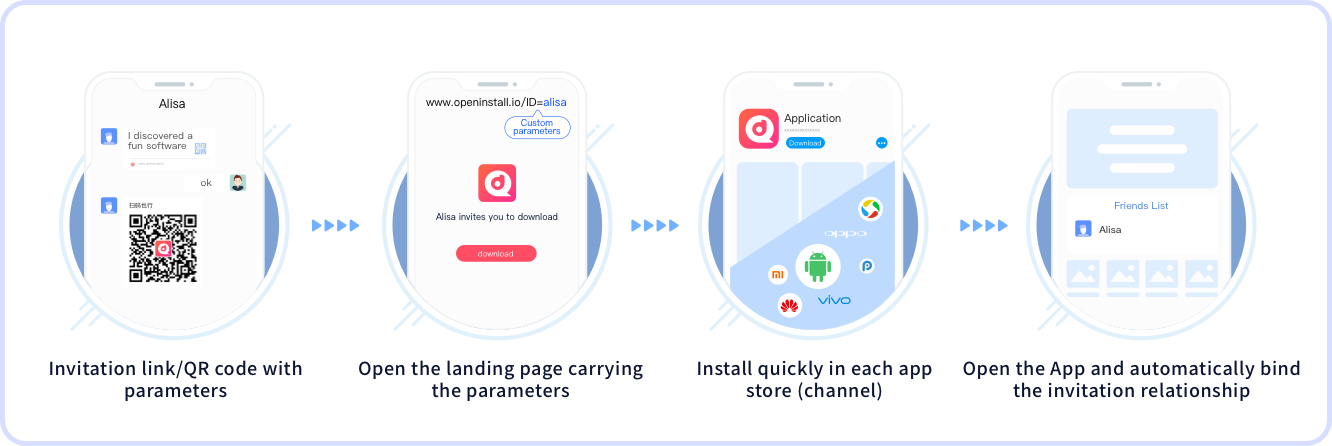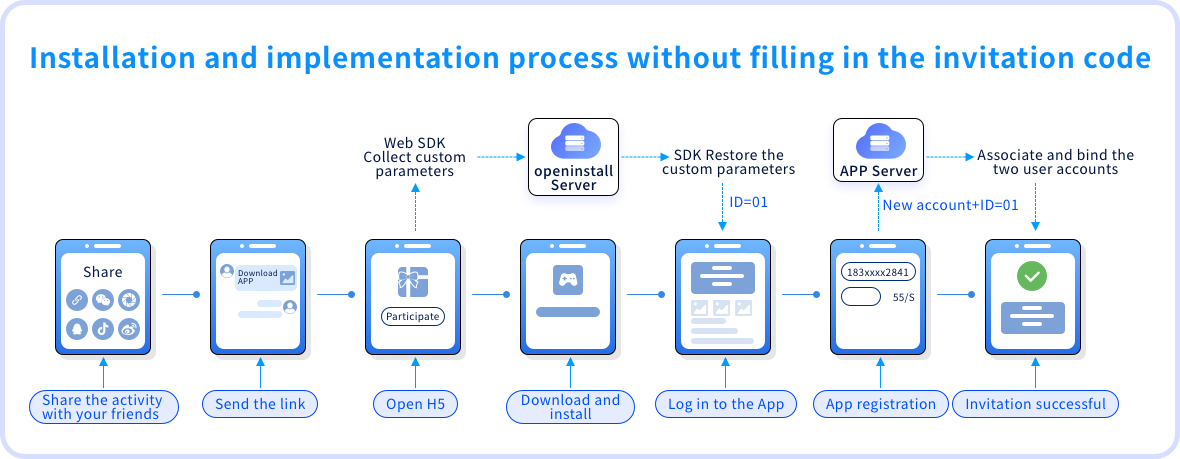
The principle of the App's no-invitation code function
- 2025.06.03 16:32
- openinstall
- Openinstall News
Overview of No-Fill Invitation Codes
App installation without requiring users to fill in invitation codes refers to scenarios where an app needs to identify the installation source (e.g., referral rewards between friends, performance tracking for ground promotions). In such cases, new users can automatically be recognized as being invited by a specific user without needing to manually input “invitation codes,” “promotion codes,” or other identifiers. This enables automatic distribution of referral rewards, automatic binding of identity relationships, and similar effects after the user installs the app.

Workflow of No-Fill Invitation Codes
The no-fill invitation code feature is implemented using openinstall’s parameter-carrying installation functionality. Through the openinstall SDK, custom parameters from a download page (H5 page) URL can be passed to the target app to identify the installation source.
For example:
When a user downloads the app via a landing page with the URL www.****.com?id=1234&name=jack (the download page must integrate the openinstall web SDK to pass parameters), the new user will have the parameters id=1234 and name=jack automatically retrieved through the installation parameter callback method (getInstall) provided by the openinstall SDK after installing and opening the app. This allows the app to determine which link the installation originated from.
By obtaining the key installation source parameters, the same effect as invitation code binding can be achieved. For instance, during new user registration, the id=1234 parameter can be uploaded to the server. The server then recognizes that the user registered with the “id=1234” referral parameter, identifies the inviter, binds the relationship, or directly issues rewards.
To pass multiple custom parameters (e.g., name, type, source), simply separate them with & in the URL. These parameters can also be retrieved after user activation for further analysis of the installation source.
As mentioned earlier, the no-fill invitation code feature is based on parameter-carrying app installation. openinstall has over five years of technical iteration experience in this field, with over 4 billion parameter-passing app installations served.
Developers can quickly implement the no-fill invitation code feature by following openinstall’s documentation:

- Step 1: Integrate the Android and iOS SDKs into the app, and integrate the web SDK into the download landing page. Use the Online Testing feature in the openinstall console to verify parameter passing.
- Step 2: Dynamically append custom parameters to the URL of the download landing page (after integrating the web SDK).
- Step 3: When a user visits the landing page, the parameters are temporarily stored on openinstall’s servers. After the user downloads and opens the app, retrieve the parameters via the installation parameter callback method in the openinstall Android/iOS SDK.
Subsequent steps, such as binding relationships or issuing rewards, can be handled by the developer’s backend based on business needs. Once implemented, the no-fill invitation code feature is fully operational.
openinstall is solely responsible for parameter passing during the process. Based on parameter-carrying installation, it can also enable functionalities like user sharing analytics, automatic friend addition post-installation, and other features requiring installation source identification.
Key Advantages of No-Fill Invitation Codes
1.Reduced Development Costs
Traditional account matching or invitation code systems require dedicated data-matching infrastructure. With the no-fill invitation code solution, developers can achieve the same results by integrating the SDK—eliminating the need for extensive development time, manpower, or server resources. This aligns with agile deployment and efficient product development.
2.Simplified User Journey
In scenarios like referrals, sharing, or ground promotions, users no longer need to manually input invitation codes or promotion codes. By simply installing and registering via the download page, relationship binding, reward distribution, and performance tracking occur seamlessly in the background.
- Beyond this, the “invitation code” concept can be flexibly adapted across app scenarios to streamline operations:
- Education apps can automatically bind users to a class without requiring a “class number.”
- Social apps can auto-add friends without needing to search for a “username.”
- Government service apps can auto-track performance metrics without requiring a “phone number.”
- Live-streaming apps can auto-follow a livestream room without searching for a “room ID.”
- Finance apps can auto-bind clients to agents without inputting an “employee ID.”
- Gaming apps can auto-join multiplayer rooms without searching for a “room code.”
- O2O apps can auto-establish distribution relationships without requiring a “promotion code.”
Simplifying the user journey significantly boosts installation conversion rates. In the user conversion process, every additional step risks drop-offs. By eliminating manual inputs, no-fill invitation codes drastically improve conversion rates, driving rapid user growth.
Recent Posts
- OpenInstall Omnichannel Multi-scenario Solution
- Having trouble acquiring users and achieving conversions for your app? Here are solutions based on real-world examples.
- openinstall: A solution for attribution and redirection from web to app (W2A).
- How to efficiently use app data statistics
- In today’s wave of social networks, how should developers make good use of omni-channel statistics?
- ASA Attribution Statistics: Breaking Through the Gap in iOS Customer Acquisition Data from a Developer’s Perspective, Making Advertising Decisions More Traceable
- Openinstall Core Function Usage Guid
- What benefits can a Web to App attribution solution bring?
- IMore than just “data calculation”: The underlying logic of APP channel agent statistics is the key to doubling conversion efficiency
- How to Use App Install Parameters for Channel Attribution



